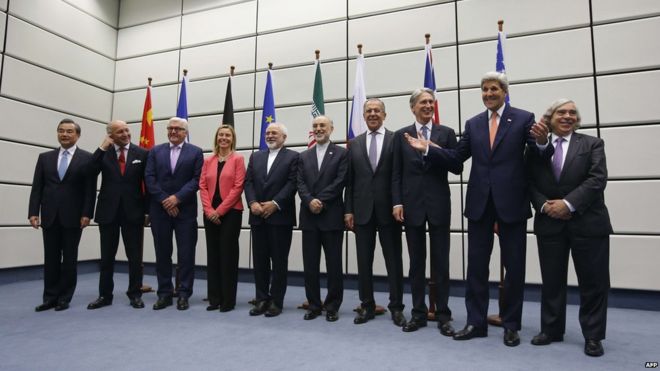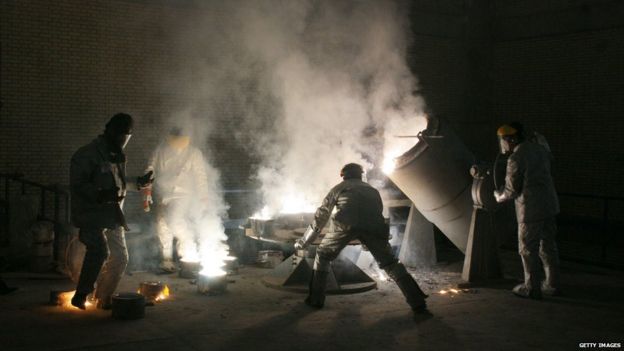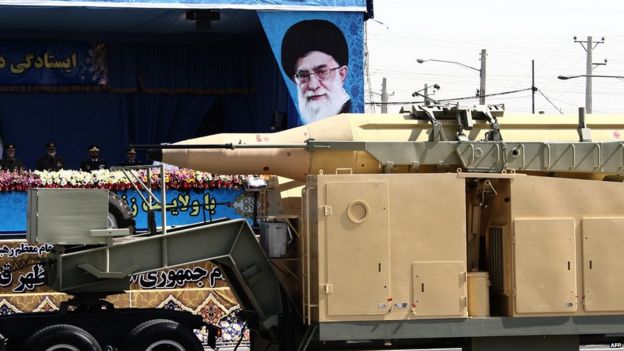Iran nuclear deal: Key details
 Image copyrightAFP
Image copyrightAFPThe 2015 nuclear deal struck between Iran and six world powers – the US, UK, Russia, France, China, and Germany – was the signature foreign policy achievement of Barack Obama’s presidency.
The initial framework lifted crippling economic sanctions on Iran in return for limitations to the country’s controversial nuclear energy programme, which international powers feared Iran would use to create a nuclear weapon.
But Mr Obama’s close association with the deal put it in the crosshairs of his successor, Donald Trump, who has announced that he will not recertify it.
President Trump claimed that the deal was too lenient and that Iran had broken parts of the agreement, including heavy-water limits and access to international inspectors.
He called for new sanctions on Iran, directed against its Revolutionary Guard police force, and referred the deal to Congress for changes to the US terms.
In response, the EU’s foreign policy chief Federica Mogherini said there had been “no violations” by Iran and insisted that the deal could not be renegotiated, even by the US.
Here are some of the key components of the original framework.
Uranium enrichment
 Image copyrightGETTY IMAGES
Image copyrightGETTY IMAGESThere are two uranium enrichment facilities in Iran – Natanz and Fordo – where uranium hexafluoride gas is fed into centrifuges to separate out the most fissile isotope U-235. Low-enriched uranium, which has a 3%-4% concentration of U-235, can be used to produce fuel for nuclear power plants. But it can also be enriched to the 90% needed to produce nuclear weapons.
In July 2015, Iran had almost 20,000 centrifuges. Under the Joint Comprehensive Plan of Action (JCPOA), it will be limited to installing no more than 5,060 of the oldest and least efficient centrifuges at Natanz for 10 years.
 Image copyrightBBC SPORT
Image copyrightBBC SPORTIran’s uranium stockpile is set to be reduced by 98% to 300kg (660lbs) for 15 years. It must also keep its level of enrichment at 3.67%.
By January 2016, Iran had drastically reduced the number of centrifuges installed at Natanz and Fordo, and shipped tonnes of low-enriched uranium to Russia.
In addition, research and development will take place only at Natanz and be limited for eight years. No enrichment will be permitted at Fordo for 15 years, and the underground facility will be converted into a nuclear, physics and technology centre. The 1,044 centrifuges at the site will produce radioisotopes for use in medicine, agriculture, industry and science.
Plutonium pathway
 Image copyrightAFP
Image copyrightAFPIran had been building a heavy-water nuclear facility near the town of Arak. Spent fuel from a heavy-water reactor contains plutonium suitable for a nuclear bomb.
World powers had originally wanted Arak dismantled because of the proliferation risk. Under an interim nuclear deal agreed in November 2013, Iran agreed not to commission or fuel the reactor.
Instead, it agreed to redesign the reactor so it cannot produce any weapons-grade plutonium. All spent fuel will be sent out of the country as long as the modified reactor exists.
Most of the 20 tonnes of heavy water the Arak facility was expected to produce will be shipped to the US via a third country, according to Iranian officials. About 6 tonnes will be retained to make medical isotopes.
The JCPOA says Iran will not be permitted to build additional heavy-water reactors or accumulate any excess heavy water for 15 years.
Covert activity
 Image copyrightAFP
Image copyrightAFPAt the time of the agreement, the White House expressed confidence that the JCPOA would prevent Iran from building a nuclear programme in secret. Iran, it said, had committed to “extraordinary and robust monitoring, verification, and inspection”.
Inspectors from the IAEA, the global nuclear watchdog, continuously monitor Iran’s declared nuclear sites and also verify that no fissile material is moved covertly to a secret location to build a bomb.
Iran also agreed to implement the Additional Protocol to their IAEA Safeguards Agreement, which allows inspectors to access any site anywhere in the country they deem suspicious.
For the 15 years of the agreement, Iran will have 24 days to comply with any IAEA access request. If it refuses, an eight-member Joint Commission – including Iran – will rule on the issue. It can decide on punitive steps, including the reimposition of sanctions. A majority vote by the commission suffices.
‘Break-out time’
 Image copyrightAFP
Image copyrightAFPBefore July 2015, Iran had a large stockpile of enriched uranium and nearly 20,000 centrifuges, enough to create eight to 10 bombs, according to the White House. US experts estimated then that if Iran had decided to rush to make a bomb, it would take two to three months until it had enough 90%-enriched uranium to build a nuclear weapon – the so-called “break-out time”.
The White House said the JCPOA would remove the key elements Iran would need to create a bomb and increase its break-out time to one year or more.
Iran also agreed not to engage in activities, including research and development, which could contribute to the development of a nuclear bomb.
In December 2015, the IAEA’s board of governors voted to end its decade-long investigation into the possible military dimensions of Iran’s nuclear programme.
The agency’s director-general, Yukiya Amano, said the report concluded that until 2003 Iran had conducted “a co-ordinated effort” on “a range of activities relevant to the development of a nuclear explosive device”. Iran continued with some activities until 2009, but after that there were “no credible indications” of weapons development, he added.
Lifting sanctions
 Image copyrightAFP
Image copyrightAFPSanctions previously imposed by the UN, US and EU in an attempt to force Iran to halt uranium enrichment crippled its economy, costing the country more than $160bn (£110bn) in oil revenue from 2012 to 2016 alone. According to the deal, Iran stood to gain access to more than $100bn in assets frozen overseas, and was able to resume selling oil on international markets and using the global financial system for trade.
Should Iran violate any aspect of the deal, the UN sanctions will automatically “snap back” into place for 10 years, with the possibility of a five-year extension.
If the Joint Commission cannot resolve a dispute, it will be referred to the UN Security Council.
Iran also agreed to the continuation of the UN arms embargo on the country for up to five years, although it could end earlier if the IAEA is satisfied that its nuclear programme is entirely peaceful. A UN ban on the import of ballistic missile technology will also remain in place for up to eight years.












